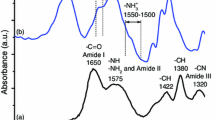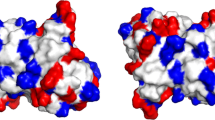Abstract
The introduction of a hydrophobic moiety on chitosan enhances the self-assembling properties, mucoadhesion, the permeability of the macromolecule and aids in target specific delivery. Our group synthesized a hydrophobic trans N-(6,6-Dimethyl-2-hepten-4-ynyl)chitosan derivative (CSD) and studied the surface modification of ZnS nanoparticles in a single pot reaction. X-ray diffraction studies and FESEM imaging confirms the nano size and morphology of the surface modified Zinc sulfide nanoparticles (ZnS-CSD NPs). The proposed ZnS-CSD NPs showed excellent emission at 457 nm. Photostability studies indicate that the surface modified ZnS-CSD NPs possess better photostability than Rhodamine B and FITC. Cell viability tests confirmed the biocompatibility of the modified nanoparticles. All these features of ZnS- CSD NPs makes these candidates an excellent choice in a wide range of in vitro or in vivo studies as fluorescent biological labels.







Similar content being viewed by others
References
Stewart BW, Wild CP (Eds.): World Cancer Report (2014) International Agency for Research on Cancer (IARC), 2014. 630pp
Prashant A, Gustav JS, Klaas N (2010) Chitosan-based systems for molecular imaging. Adv Drug Deliv Rev 62:42–58
Chan WC, Maxwell DJ, Gao X, Bailey RE, Han M, Nie S (2002) Luminescent quantum dots for multiplexed biological detection and imaging. Curr Opin Biotechnol 13(1):40–46
Hwang JM et al (2005) Preparation and characterization of ZnS-based monocrystalline particles for polymer light-emitting diodes. Curr Appl Phys 5(1):31–34
Cho H et al (2009) Highly flexible organic light-emitting diodes based on ZnS/Ag/WO3 multilayers transparent electrodes. Org Electron 10(6):1163–1169
Ji Z, Xiao-X F, Jin Q, Zhi-F Z, Yan-M M, Gui-Q Y (2016) A sensitive phosphorescence method based on MPA-capped Mn-doped ZnS quantum dots for the detection of diprophylline. New J Chem 40:3857–3862
Haiying W, Xiaofeng L, Yiyang Z, Ce W (2006) Preparation and characterization of ZnS: Cu/PVA composite nanofibers via electrospinning. Mater Lett 60:2480–2484
Pallab S, Shivendra BP, Arun C, Siddhartha SG (2010) Incorporation of gene therapy vector in chitosan stabilized Mn2+-doped ZnS quantum dot. Mater Lett 64:2534–2537
Haizhen H, Xiurong Y (2004) Synthesis of polysaccharide-stabilized gold and silver nanoparticles: a green method. Carbohydr Res 339:2627–2631
Sugunan A, Thanachayanont C, Dutta JG (2005) Heavy metal ion sensors using chitosan-capped gold nanoparticles. Sci Technol Adv Mater. doi:10.1016/j.stam.2005.03.007
Alves NM, Mano JF (2008) Chitosan derivatives obtained by chemical modifications for biomedical and environmental applications. Int J Biol Macromol 43:401–414
Muzzarelli RAA (1997) Human enzymatic activities related to the therapeutic administration of chitin derivatives. Cell Mol Life Sci 53:131–140
Bersch PC, Nies B, Liebendorfer A (1995) Evaluation of the biological properties of different wound dressing materials. J Mater Sci Mater Med 6:231–240
Sudheesh KS, Mishra AK, Omotayo AA, Bhekie BM (2013) Chitosan-based nanomaterials: a state-of-the-art review. Int J Biol Macromol 59:46–58
Bhattarai N, Gunn J, Zhang M (2010) Chitosan-based hydrogels for controlled, localized drug delivery. Adv Drug Deliv Rev 62:83–99
Gupta K, Ravi Kumar M (2000) Drug release behavior of beads and micro granules of chitosan. Biomaterials 21:1115–1119
Hari P, Chandy T, Sharma CP (1996) Chitosan/calcium–alginate beads for oral delivery of insulin. J Appl Polym Sci 59:1795–1801
Hirano S (1999) Chitin and chitosan as novel biotechnological materials. Polym Int 48:732–734
Yu Y, Shengpeng W, Yitao W, Xiaohui W, Qun W, Meiwan C (2014) Advances in self-assembled chitosan nanomaterials for drug delivery. Biotechnol Adv 32:1301–1316
Huo M, Zhang Y, Zhou J, Zou A, Yu D, Wu Y et al (2010) Synthesis and characterization of low toxic amphiphilic chitosan derivatives and their application as micelle carrier for the antitumor drug. Int J Pharm 394:162–173
Opanasopit P, Ngawhirunpat T, Chaidedgumjorn A, Rojanarata T, Apirakaramwong A, Phongying S et al (2006) Incorporation of camptothecin into N-phthaloyl chitosan-gmPEGself-assembly micellar system. Eur J Pharm Biopharm 64:269–276
Liu K-H, Chen B-R, Chen S-Y, Liu D-M (2009) Self-assembly behavior and doxorubicin-loading capacity of acylated carboxymethyl chitosans. J Phys Chem B 113:11800–11807
Lee C, Choi JS, Kim I, Byeon HJ, Kim TH, Oh KT et al (2014) Decanoic acid-modified glycol chitosan hydrogels containing tightly adsorbed palmityl-acylated exendin-4 as a long-acting sustained-release anti-diabetic system. Acta Biomater 10:812–820
Wang Y-S, Jiang Q, Li R-S, Liu L-L, Zhang Q-Q, Wang Y-M, Zhao J(2008) Self-assembled nanoparticles of cholesterol-modified O-carboxymethyl chitosan as a novel carrier for paclitaxel. Nanotechnology 19:145101
Desbrieres J, Martinez C, Rinaudo M (1996) Hydrophobic derivatives of chitosan: characterization and rheological behavior. Int J Biol Macromol 19:21–28
Jayakumar R, Prabakaran M, Muzzarelli RAA (2011) Chitosan for biomaterials II. Springer Verlag, Berlin Heidelberg, pp 24–32
Hitoshi S, Yoshihiro S (1999) Chemical modification of chitin and chitosan 2: preparation and water soluble property of N-acylated or N-alkylated partially deacetylated chitins. Carbohydr Polym 39:127–138
Chan Le T, Monique L,Pompilia I-S, Mircea AM (2003) N-acylated chitosan:hydrophobic matrices for controlled drug release. J.Control.Release 93:1–13
Hermanson GT (2013) Bioconjugate Techniques, 3rd Edition, Academic Press, Elsevier.
Manjusha EM, Jithin CM, Manzoor K, Nair SV, Tamura H, Jayakumar R (2010) Folate conjugated carboxymethyl chitosan–manganese doped zinc sulfide nanoparticles for targeted drug delivery and imaging of cancer cells. Carbohydr Polym 80:443–449
Siti M, Ara SM, Andrew MacKay J (2010) Imaging and drug delivery using theranostic nanoparticles. Adv Drug Deliv Rev 62:1052–1063
Ramanery FP, Mansur AAP, Mansur HS (2013) One-step colloidal synthesis of biocompatible water-soluble ZnS quantum dot/chitosan nanoconjugates. Nanoscale Res Lett 8:512
Sureshkumar S, Jothimani B, Sridhar TM, Venkatachalapathy B (2016a) Synthesis and characterization of gadolinium-doped ZnSe quantum dots for fluorescence imaging of cancer cells. RSC Adv 6:16081–16086
Sureshkumar S, Jothimani B, Sridhar TM, Venkatachalapathy B (2016b) Synthesis of hexagonal ZnO-PQ7 nanodisks conjugated with folic acid to image MCF −7 cancer cells. J Fluoresc. doi:10.1007/s10895-016-1932-y
Ummartyotin S, Bunnak N, Juntaro J, Sain M, Manuspiya H (2012) Synthesis and luminescence properties of ZnS and metal (Mn, Cu)-doped-ZnS ceramic powder. Solid State Sci 14:299–304
Chang S-Q, Kang B, Dai Y-D, Zhang H-X, Chen D (2011) One-step fabrication of biocompatible chitosan coated ZnS and ZnS: Mn2+ quantum dots via gamma-radiation route. Nanoscale Res Lett 6:591
Wageh S, Ling ZS, Xu-Rong X (2003) Growth and optical properties of colloidal ZnS nanoparticles. J Cryst Growth 255:332–337
Tarasov K, Houssein D, Destarac M, Marcotte N, Gérardin C, Tichit D (2013) Stable aqueous colloids of ZnS quantum dots prepared using double hydrophilic block copolymers. New J Chem 37:508–514
Zheng Y, Gao S, Ying JY (2007) Synthesis and cell imaging applications of glutathione-capped CdTe quantum dots. Adv Mater 19:376–380
Barman B, Sarma KC (2011) Luminescence properties of ZnS quantum dots embedded in polymer matrix. Chalcogenide Lett 8:171–176
Xue Z, Shengjiang W, Weijia Z, Jichuan Q, Yongzhong W, Hongzhi L, Chengwei X, Xiaopeng H (2014) Highly biocompatible POSS-coated CdTe quantum dots for cell labeling. RSC Adv 4:598
Rozenberg BA, Tenne R (2008) Polymer-assisted fabrication of nanoparticles and nanocomposites. Prog Polym Sci 33:40–112
Author information
Authors and Affiliations
Corresponding author
Rights and permissions
About this article
Cite this article
Jothimani, B., Sureshkumar, S. & Venkatachalapathy, B. Synthesis and Characterization of Surface Modified, Fluorescent and Biocompatible ZnS Nanoparticles with a Hydrophobic Chitosan Derivative. J Fluoresc 27, 1277–1284 (2017). https://doi.org/10.1007/s10895-017-2059-5
Received:
Accepted:
Published:
Issue Date:
DOI: https://doi.org/10.1007/s10895-017-2059-5




